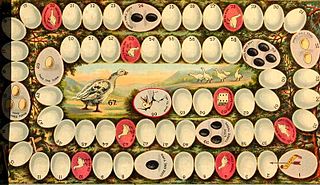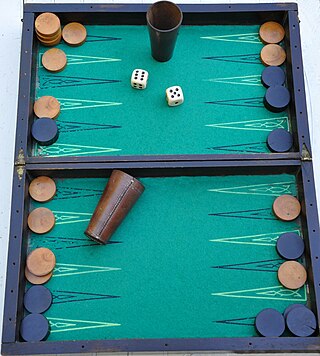Related Research Articles

Board games are tabletop games that typically use pieces. These pieces are moved or placed on a pre-marked board and often include elements of table, card, role-playing, and miniatures games as well.

Dice are small, throwable objects with marked sides that can rest in multiple positions. They are used for generating random values, commonly as part of tabletop games, including dice games, board games, role-playing games, and games of chance.

A Eurogame, also called a German-style board game, German game, or Euro-style game, is a class of tabletop games that generally has indirect player interaction and multiple ways to score points. Eurogames are sometimes contrasted with American-style board games, which generally involve more luck, conflict, and drama. They are usually less abstract than chess or Go, but more abstract than wargames. Likewise, they generally require more thought and planning than party games such as Pictionary or Trivial Pursuit.

Monopoly is a multi-player economics-themed board game. In the game, players roll two dice to move around the game board, buying and trading properties and developing them with houses and hotels. Players collect rent from their opponents and aim to drive them into bankruptcy. Money can also be gained or lost through Chance and Community Chest cards and tax squares. Players receive a salary every time they pass "Go" and can end up in jail, from which they cannot move until they have met one of three conditions. House rules, hundreds of different editions, many spin-offs, and related media exist. Monopoly has become a part of international popular culture, having been licensed locally in more than 103 countries and printed in more than 37 languages. As of 2015, it was estimated that the game had sold 275 million copies worldwide. The original game was based on locations in Atlantic City, New Jersey, United States.

Steve Jackson Games (SJGames) is a game company, founded in 1980 by Steve Jackson, that creates and publishes role-playing, board, and card games, and the gaming magazine Pyramid.

Risk is a strategy board game of diplomacy, conflict and conquest for two to six players. The standard version is played on a board depicting a political map of the world, divided into 42 territories, which are grouped into six continents. Turns rotate among players who control armies of playing pieces with which they attempt to capture territories from other players, with results determined by dice rolls. Players may form and dissolve alliances during the course of the game. The goal of the game is to occupy every territory on the board and, in doing so, eliminate the other players. The game can be lengthy, requiring several hours to multiple days to finish. European versions are structured so that each player has a limited "secret mission" objective that shortens the game.

Boggle is a word game in which players try to find as many words as they can from a grid of lettered dice, within a set time limit. It was invented by Allan Turoff and originally distributed by Parker Brothers. The game is played using a plastic grid of lettered dice, in which players look for words in sequences of adjacent letters.

Tabula, meaning a plank or board, was a Greco-Roman board game for two players that has given its name to the tables family of games of which backgammon is a member.

Louis Zocchi is a gaming hobbyist, former game distributor and publisher, and maker and seller of polyhedral game dice. In 1986, he was elected to the Charles Roberts Awards Hall of Fame.

Can't Stop is a board game designed by Sid Sackson originally published by Parker Brothers in 1980; however, that edition has been long out of print in the United States. It was reprinted by Face 2 Face Games in 2007. An iOS version was developed by Playdek and released in 2012. The goal of the game is to "claim" three of the columns before any of the other players can. But the more that the player risks rolling the dice during a turn, the greater the risk of losing the advances made during that turn.

The Game of the Goose or goose game is a board game where two or more players move pieces around a track in a stepwise manner, according to a number of steps corresponding to the result of the rolling of one or two dice. The aim of the game is to reach square number 63 before any of the other players, while avoiding obstacles such as the Inn, the Bridge, and Death.

Nard is an historical Persian tables game for two players that is sometimes considered ancestral to backgammon. It is still played today, albeit in a different form. As in other tables games, the playing pieces are moved around a board according to rolls of dice. It uses a standard tables board, but has a different opening layout and rules of play from that of backgammon.

Napoleon, subtitled "The Waterloo Campaign, 1815", is a strategic-level block wargame published by Gamma Two Games in 1974 that simulates the Battle of Waterloo. A number of versions of the game have been produced by Avalon Hill and Columbia Games.
Sniper!, subtitled "House-to-House Fighting in World War II", is a two-player board wargame about man-to-man combat in urban environments during WWII, originally released in 1973 by Simulations Publications Inc. (SPI). After TSR purchased SPI in 1982, TSR released an expanded edition of Sniper! in 1986, and followed up that up with releases of various "companion games" and a videogame.
Blood Royale is a board game based on medieval Europe, published by Games Workshop in 1987 and designed by Derek Carver. The lead artist was Christos Achilleos. The game is currently out of print.

The history of games dates to the ancient human past. Games are an integral part of all cultures and are one of the oldest forms of human social interaction. Games are formalized expressions of play which allow people to go beyond immediate imagination and direct physical activity. Common features of games include uncertainty of outcome, agreed upon rules, competition, separate place and time, elements of fiction, elements of chance, prescribed goals and personal enjoyment.

Game design is the process of creating and shaping the mechanics, systems, and rules of a game. Games can be created for entertainment, education, exercise, or experimental purposes. Increasingly, elements and principles of game design are also applied to other interactions, in the form of gamification. Game designer and developer Robert Zubek defines game design by breaking it down into its elements, which he says are the following:

Freedom: The Underground Railroad is a 2013 co-operative board game designed by Brian Mayer and published by Academy Games, their first game in the Freedom Series. The game has drawn positive attention for its approach and handling of the topic.

War of 1812, subtitled in the first edition "La Guerre de 1812", is a board wargame published in 1973 by Gamma Two Games,, that simulates the War of 1812.

The following is a glossary of terms used in tables games, essentially games played on a Backgammon-type board. Terms in this glossary should not be game-specific, but applicable to a range of tables games.
References
- ↑ Marsden, Rhodri (13 September 2014). "Rhodri Marsden's Interesting Objects: The first British board game" . Indy/Life: Independent Print Limited. The Independent. Archived from the original on 13 June 2022. Retrieved 26 September 2019.
- ↑ Margaret Drabble (September 2010). The Pattern in the Carpet: A Personal History with Jigsaws. Houghton Mifflin Harcourt. p. 107. ISBN 978-0-547-38609-6 . Retrieved 26 September 2019.
- ↑ Dove, Jane (2 January 2016). "Geographical board game: promoting tourism and travel in Georgian England and Wales". Journal of Tourism History. 8 (1): 1–18. doi: 10.1080/1755182X.2016.1140825 . ISSN 1755-182X.
- ↑ Seville, Adrian (31 December 2008). "The geographical Jeux de l'Oie of Europe". Belgeo. Revue belge de géographie (3–4): 427–444. doi: 10.4000/belgeo.11907 . ISSN 1377-2368.
- 1 2 Seville, Adrian (April 2008). "The Sociable Game of the Goose". Proceedings of Board Game Studies Colloquium. XI: 1005–1006 – via Academia.edu.
- ↑ FRB Whitehouse: Table Games of Georgian and Victorian Days, London, 1951, revised 2nd edition Priory House (Herfortshire) 1971, p. 6f.
- ↑ Edney, Matthew H.; Pedley, Mary Sponberg (15 May 2020). The History of Cartography, Volume 4: Cartography in the European Enlightenment. University of Chicago Press. ISBN 978-0-226-33922-1.
- ↑ Kelly, John F. "The Dice of Life". The Washington Post. Retrieved 3 January 2021.